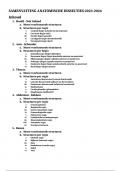Samenvatting
Summary Important Concepts and Formulas for 'Introduction to Biomedical Sciences' (AB_1136)
In this document, I explain all the important concepts, theories, terms, and formulas needed to pass the exam of 'Introduction to Biomedical Sciences'. This summary helped me pass the course with a 7,5.
[Meer zien]













